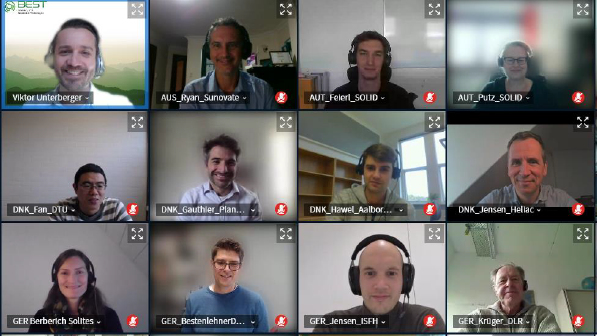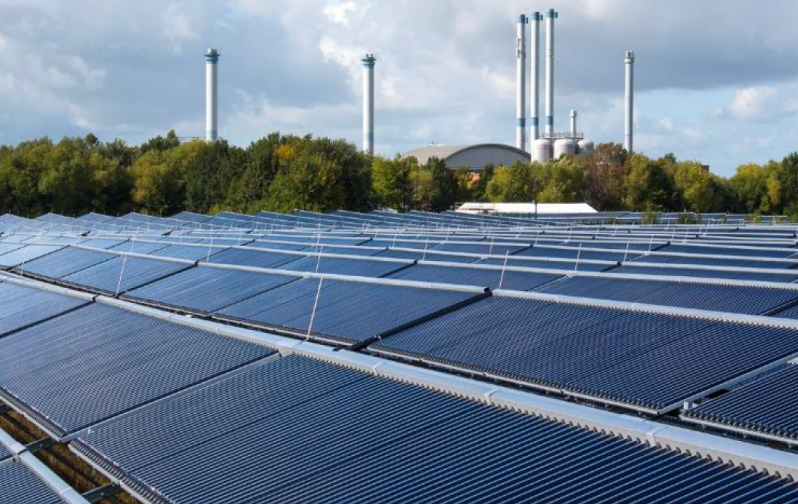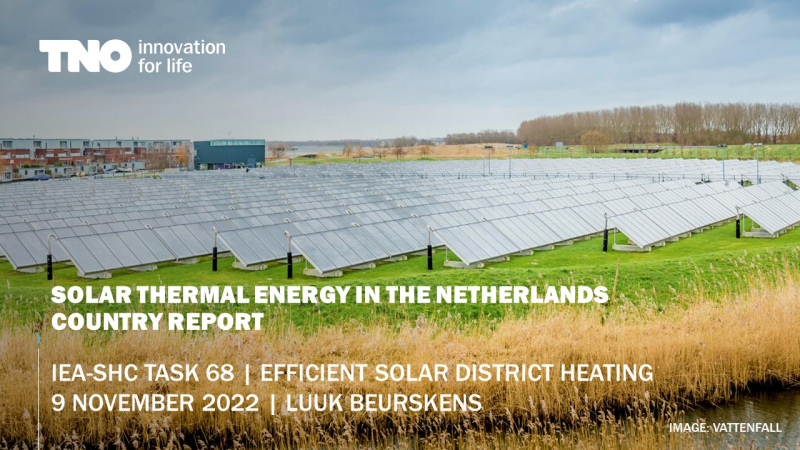Posted: December 7, 2022

Screenshot: IEA SHC Task 68
A well-attended second meeting of the research group IEA SHC Task 68 Efficient Solar District Heating took place at the beginning of November. A total of 51 participants from 15 countries – a mix of scientists and industry representatives - registered for the two-day virtual meeting. Country reports about Germany and the Netherlands provided a good insight into the status of the funding situation as well as projections of future market development. A highly relevant topic for both countries is solar district heating solutions that provide heat at 80 to 120 °C. For the first time, the national subsidy scheme SDE++ in the Netherlands added concentrating solar collectors to its call for projects in 2022.
“We have a dynamic contingent of experts from various backgrounds in the task, so we can shed light on the important issues from many different angles”, commented Viktor Unterberger, Chair of Task 68 and Senior Researcher at the Austrian BEST – Bioenergy and Sustainable Technologies centre of excellence. One of the first reports expected for next year will deliver a comparison of different collector types, especially considering technologies that provide 80 to 120 °C. This is a highly relevant topic for the German solar district heating market, where around 77 % of the heat networks operate at supply temperatures in this range. Around 21 % even operate at more than 120 °C, according to an estimate from the German research institute Solites based on market data from the German District Heating Association AGFW.
Collectors providing medium-high temperatures of 80 to 120 °C
Magdalena Berberich from Solites reported on the market development in Germany. Currently, 48 plants for solar district heating with about 142,500 m² of gross collector area are in operation in Germany. Nine plants with around 31,200 m² are in the planning phase and around 50 plants with about 286,400 m² are currently in preparation. She emphasised that if all the plants in preparation are actually built, the market volume could double in the coming years.
Berberich also talked about solar district heating plants that provide constant temperatures above 80 °C. The vacuum tube collector field in Lemgo, northern Germany, with 9,181 m2 operates at different flow rates in the solar circuit to achieve a constant target temperature of 90 °C, as the technology provider Viessmann confirmed on request. Furthermore, a 6,086 m2 collector field is under development in Sondershausen, central Germany, which will include evacuated flat-plate collectors that have proven their capability to provide heat at 85 °C even on sunny winter days. According to the manufacturer, this collector can produce up to 160 °C.

Largest SDH plant in Germany with 13 MW at the costal town of Greifswald
Photo: Guido Broer, Solarthemen
The bottlenecks according to Berberich are still the availability of land and the long permission procedures. The largest German SDH plant in Greifswald, near the Baltic Sea received funding from the Innovative Combined Heat and Power scheme. “In this scheme the plant must be implemented within four years. Getting the permission to build the collector field, however, took 2.5 years, making this a critical point in the project’s realisation”, said Berberich. Concerning the available land areas, the region Baden-Württemberg is discussing how to integrate areas for solar thermal into the regional planning routines to simplify obtaining permissions.
1 million m2 SDH collector area per year until 2050 to fulfil climate goals
She also pointed out the huge SDH potential in Germany, which can be roughly estimated using the following figures. Scenarios calculated on behalf of the Economy Ministry in 2021 resulted in an average potential share of solar heat in district heating by 2050 of 13.5 TWh. With an annual solar yield of 400 kWh/m² gross collector area, up to 30 million m² would be needed to achieve this goal. Broken down to an annual share, this means more than 1 million m² of new SDH collector area per year is required across the country. This is a challenging target when compared with the 142,500 m2 SDH area that was in operation by September 2022 in Germany.

Four important pieces of news from the Netherlands
Luuk Beurskens of TNO, the Netherlands Organisation for Applied Scientific Research, had four important pieces of information for the SDH research community.
Firstly, he reported about the start of construction of the 37 MW district heating plant in Groningen (48,000 m2). Solarthermalworld.org already published a report about this on 11 November.
Secondly, he announced that as of 2022, concentrating solar thermal collectors are eligible for the SDE++ subsidy scheme. SDE++ is a performance-based incentive that pays a feed-in premium for each kilowatt-hour produced by collector fields of more than 200 m2 over 15 years up to a certain maximum amount of kilowatt hours per year. The feed-in premium is annually revised and the net subsidy amount is determined by the difference between the cost of solar heat and the cost of heat produced by a gas boiler. Provisional subsidy rates in 2022 for solar heat plants above 1 MWth were 5.13 EUR-cent/kWh. This premium is the result of deducting heat costs using gas of 2.95 EUR cents/kWh from the solar heat production costs of 8.08 EUR cents/kWh.
In a letter to parliament of 23 November it was announced that in 2022 a total of three applications for solar thermal were handed in with a cumulative thermal capacity of 10 MW. Together, these projects may receive up to EUR 5 million in subsidies. The exact amount, however, will depend on the gas price development. It is unknown what temperature level is being targeted and which collector types will be used. Note that different feed-in premiums are in place for installations below and above 1 MW thermal capacity.
Solar heat is below the radar of Dutch policy makers
Thirdly, Beurskens emphasised the fact that policy attention is still on renewable electricity and solar heat is below the radar of policy makers. The latest Dutch Climate and Energy Outlook, released in November 2022, does not even mention solar heat as an option for decarbonising district heating by 2030. In the report published by the Netherlands Environmental Assessment Agency the following renewable shares by 2030 are anticipated: 10 PJ biomass including municipal waste, 4 PJ deep geothermal, 3 PJ electric boilers, 2 PJ aquathermal energy, and 0.7 PJ aquifer thermal storage.
SDE++ plus ETS makes SDH an interesting business case
Fourthly, the TNO researcher spoke about results from the most recent TNO report about the businesses cases for solar district heating (see link at the end of the article). Beurskens summarised that large multi-MW district heating systems with daily heat storage were found to be profitable when revenues from the SDE++ premium and the emission trading system (ETS) are considered in the calculation (see following table). Over a period of 15 years, SDE++ and ETS may provide up to EUR 7.2 million, which is 60 % of the total cost of ownership.
|
System design
|
Reference system with a gas boiler
|
50,000 m2 aperture collector area plus daily storage providing an annual solar fraction between 5 and 20 %
|
|
Total cost of ownership
|
29.6 million EUR
|
12 million EUR
|
|
Levelised cost of heat
|
8.4 EUR-cent/kWh
|
5.2 EUR-cent/kWh
|
|
Income from SDE++ together with ETS
|
|
7.2 million EUR
|
|
Payback period
|
|
9 years
|
Economic feasibility calculation for a subsidised solar district heating field compared to a gas boiler over a period of 20 years (of which 15 years with subsidy). A discount rate of 4 % was considered and a (long term) large consumer gas price of 50 EUR-cent/m3.
Source: TNO, report De Businesscase voor Zonnewarmte (The business case for solar heat), TNO R11908, October 2022
Organisations mentioned in this news article: